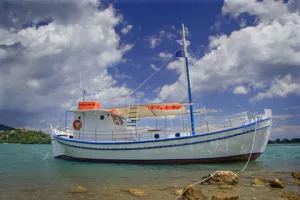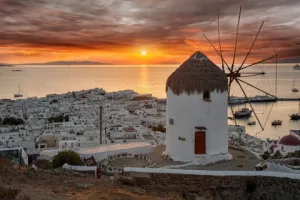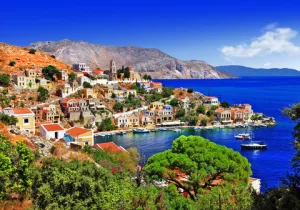Crete is not just one of the Greek islands. It is the biggest Greek island.
It is actually a state with its own history, folklore and traditions. And if Greece is rightfully considered the cradle of European civilization, then, without a doubt, Crete with its Minoan culture is the cradle of Greece!
Crete is an astonishingly diverse island that boasts gorgeous scenery and stunning architecture alike. This is why Crete is a photographer’s heaven.
In this article, we will share with you our favourite locations that your camera is sure to fall in love with.
Crete is not just one of the Greek islands. It is the biggest Greek island.
It is actually a state with its own history, folklore and traditions. And if Greece is rightfully considered the cradle of European civilization, then, without a doubt, Crete with its Minoan culture is the cradle of Greece!
Crete is an astonishingly diverse island that boasts gorgeous scenery and stunning architecture alike. This is why Crete is a photographer’s heaven.
In this article, we will share with you our favourite locations that your camera is sure to fall in love with.
1. Venetian Port in Chania
Probably the most romantic place in Crete, the Old Venetian Port is also among the most photogenic ones as well. Chania is the main city of Western Crete and one of the most beautiful settlements on the island.
The pastel-coloured buildings that line the waterfront are the perfect backdrop for the best shots you could ever wish for, especially at sunset.
The main attraction of Chania is the old town with the harbour and the Venetian fortress Firkas. Cobbled streets, harmoniously blended with the interior of the city, numerous restaurants and the spirit of antiquity give Chania a special atmosphere, which is always very difficult to part with later.
What can we add, the Venetians knew how to provide comfort to their settlements, and in the old city of Chania, their skill is still felt like nowhere else in Crete.
On top of that, the absolute star of the Venetian Port is the imposing Egyptian Lighthouse which looks splendid any time of day.
The Archaeological and Maritime Museums deserve special attention in Chania. The former presents a rich collection of artefacts reflecting the rich history of western Crete.
At the same time, the latter features an accurate model of the 17th-century city of Chania with its harbour and Venetian shipyards.
DayTrip4U Suggestion: Trikke City Tour – An Unexpected Journey in Chania
2. Balos Lagoon
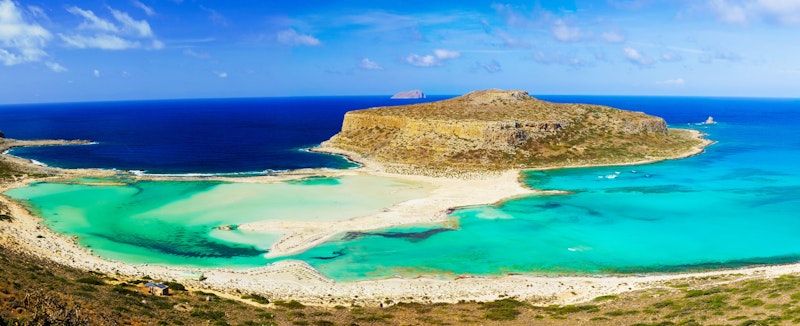
Balos Lagoon is the most exotic beach in Greece.
For that reason alone it’s definitely worthy of a place on this list of the best photography spots in Crete.
The Guardian in this 2019 article named Balos as one of the best beaches in Europe while Telegraph listed Balos as the 7th best beach in the world! So what’s this all about?
The shallow turquoise waters as they kiss the fine white sand with the imposing rock looming above is a spectacle that your cameras will absolutely love.
Getting to Balos Lagoon can be a nuisance if travelling with a car so the best way to get there is by joining a boat tour.
DayTrip4U Suggestion: Gramvousa & Balos Tour
3. Loutro
The small picturesque village of Loutro is located in the southwest of Crete between the villages of Sfakia in the east and Ayia Roumeli in the west.
There are only two ways to get to Loutro:
- by boat or
- on foot
since there are no roads, and this fact gives the village a special charm.
Arriving here by boat, you will invariably fall under the spell of both the settlement itself and the bay in which it is located. Swimming, coffee or a lazy lunch in one of the taverns on the beach – that’s all the local entertainment.
4. Elafonissi Beach
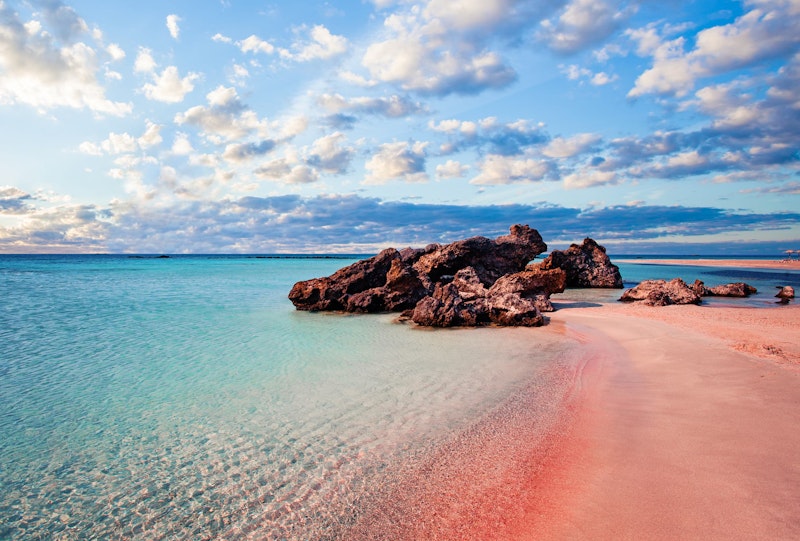
Off the southwestern tip of Crete and about 75 kilometers away from Chania, lies Elafonissi, an island that is within a small walking distance from the mainland. You will have to walk through a small and very shallow part of the sea to get there.
This exotic island – which belongs to a protected area of Natura – has fans from all over the world. Tourists go there every year because the beach is stunning, like a fairytale!
The beauty of Elafonissi Beach is almost unreal. This unique beach features pink sand and Caribbean-like crystal clear waters. Get ready for the photo opportunities of a lifetime!
5. Elounda and Spinalonga Island
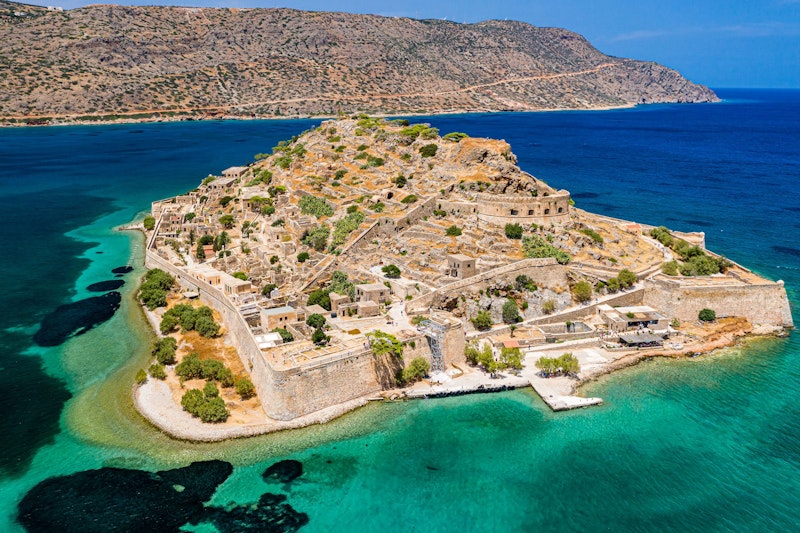
Located just a dozen kilometres from Agios Nikolaos on the coast of the Mirabello Bay, Elounda was once just a fishing village, but now it is a fashionable resort, which is famous throughout the world for its hotels.
At the same time, the small fishing port of Elounda had not lost its charm, retaining the atmosphere that prevailed here long before this place was given the status of luxury.
The local beaches are just as good, and every year they confirm their high level by receiving the EU Blue Flags for the purity of the waters and the coast.
Not far from the coast of Elounda is the island of Spinalonga. In 1579, the Venetians equipped the island with massive fortifications to guard this part of Crete.
Thanks to this, even when the Turks completely subjugated Crete in 1669, Spinalonga remained unconquered, and for almost 50 years the Venetian fortress was a constant source of headaches for the Ottomans. Spinalonga is also famous for being the last leper colony from 1903 to 1957.
During the summer months, both Elounda and Agios Nikolaos can be reached by boat to Spinalonga to get to know the island’s past in more detail.
Our Best-Seller Suggestion: Spinalonga Island: A Full Day Tour
6. Agios Nikolaos
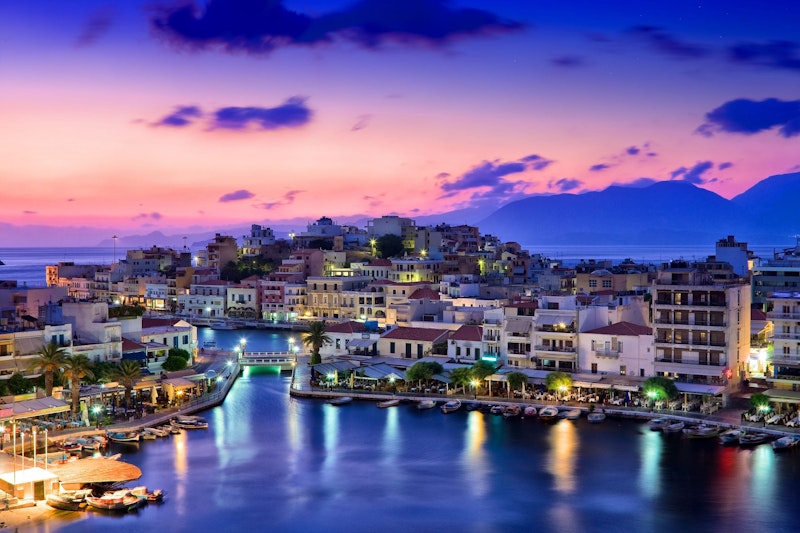
Agios Nikolaos is definitely worth a visit both for its cosmopolitan atmosphere and views. This task is facilitated by the fact that it is located just 70 kilometres from Heraklion. It would be best if you came here simply to join the crowd, immersed in the local atmosphere.
By the way, Mirabello translated from Italian means “beautiful view” – and this is true, that the Lake Voulismeni, located in its central part, gives the city a special charm. In the century before last, the lake was connected to the bay by a canal, erecting a local landmark in a square.
The promenade of Agios Nikolaos is teeming with many restaurants, taverns and eateries that offer tourists to taste local dishes, and the city’s museums offer their unique exhibits from both the pre-Christian period and our era. It also makes sense to visit the 12th century Panagia Vrefotrofu church located in the western part of the bay.
7. Village of Anoia (Anogia) and Zoniana cave (Sfendoni)
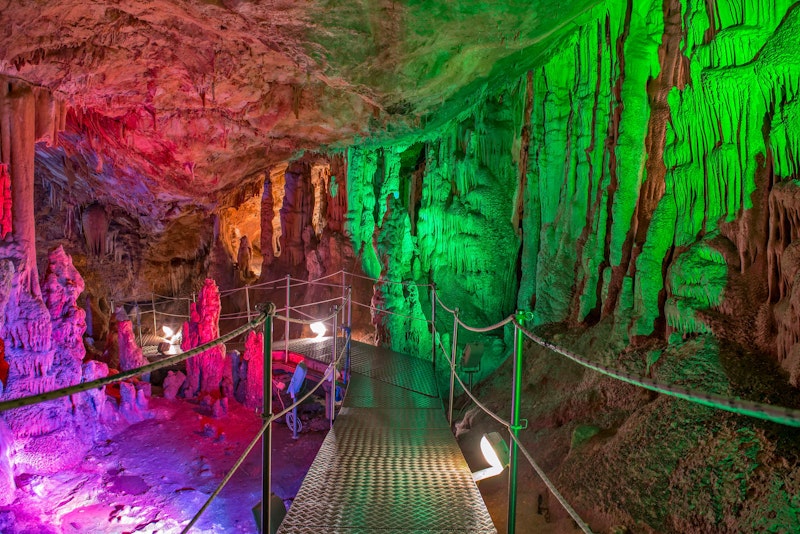
The village of Anogia is a fairly large settlement, located at an altitude of 750 meters above sea level in Rethymno prefecture.
During the Second World War, it was completely destroyed by the Germans, and all the male population, who could not escape, were shot in revenge for the participation of local resistance fighters in the abduction of General Von Kreipe.
It is also known as the birthplace of Nikos Xilouris, one of the most famous Cretan musicians of all time. He died in 1980 at the age of 43 and became a Cretan legend.
Anogia hosts local music, theatre and arts festival every July.
However, the greatest tourist interest in Anogia is associated with the nearby Sfendoni Cave, also known as Zoniana. With a length of 145 meters and an age of more than 8 million years, it is known for its numerous stalactites and stalagmites in three colours: white, red and grey.
8. Lassithi plateau and Dikteon Andron cave
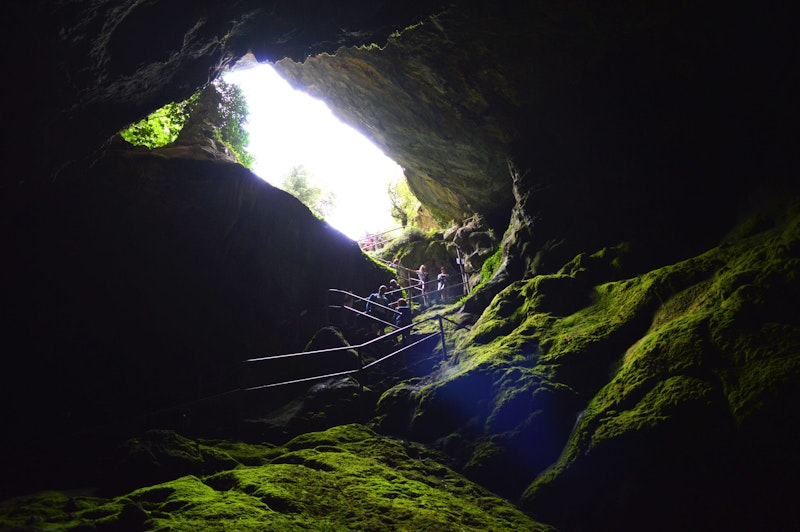
Located on a kind of border between Central and Eastern Crete, the Lassithi Plateau is one of the most interesting places on the island for 5 special reasons:
It is the highest inhabited plateau in Greece. It is one of the most picturesque places on the island, known for its mills, canals and gardens. The local flavour that distinguishes this place from the advertising posters of the resort. A whole series of bright and truly “special” places.
Mandatory points of the route include the mountain village of Crassi with its Laundry of the Venetian period and a giant plane tree, considered the oldest tree on the island, the monastery of Our Lady of Kera Kardiotissa with a miraculous icon and, the Dikteon-Andron cave, where, according to legend, Rhea gave birth to the baby Zeus.
The latter is wildly popular among tourists, and this is not only due to its connection with the supreme God of Ancient Greek mythology, located at an altitude of more than 1000 meters above sea level, the Dikteon Andron Cave is considered the most beautiful of more than 200 caves on the island.
Of the attributes connecting the cave with Zeus, there is still a small lake in which Rhea bathed the baby, as well as a forest of stalactites called the Mantle of Zeus.
9. Lake Kournas, Argyroupoli and Ancient Lappa
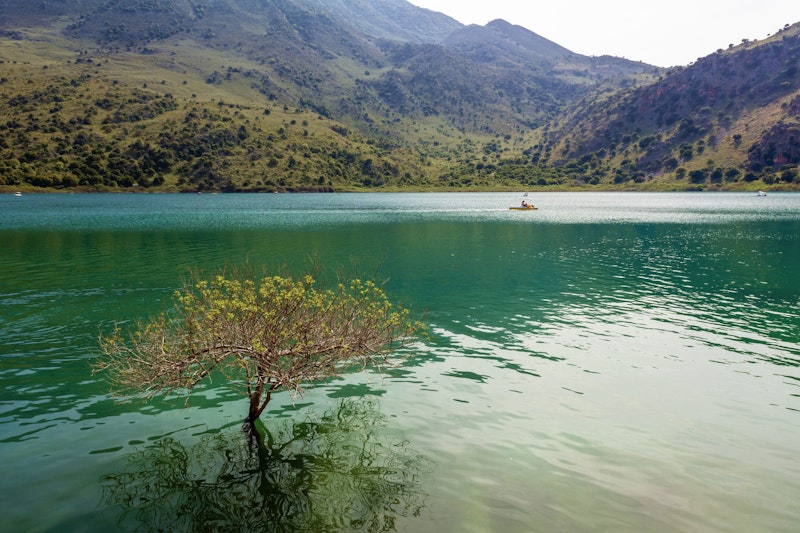
Located between Chania and Rethymno, Lake Kournas is the only natural freshwater formation in Crete. Surrounded by lush vegetation and mountains, it is a place where you will not regret spending your time.
For the entertainment of tourists on Kournas, a river tram and catamarans are arranged, and on the banks there are numerous taverns. The girls on Kournas are touched by small freshwater turtles, which are found here in large numbers.
According to legend, the lake is connected by underwater channels with underground springs in Athens, but it is difficult to believe that this myth is a reality.
A few kilometres from Kournas, on the site of the ancient city of Lappa, is the village of Argyroupoli. First of all, this place is famous for its water sources, which, under the hot Cretan sun, contributed to the growth of lush tropical vegetation, while changes in the relief led to the formation of numerous waterfalls.
Enterprising locals use the water resources of the surrounding area to power watermills, and many local houses were built, among other things, from the stones of ancient Lappa.
In the Ancient City, by the way, there is also something to see.
10. Samaria Gorge
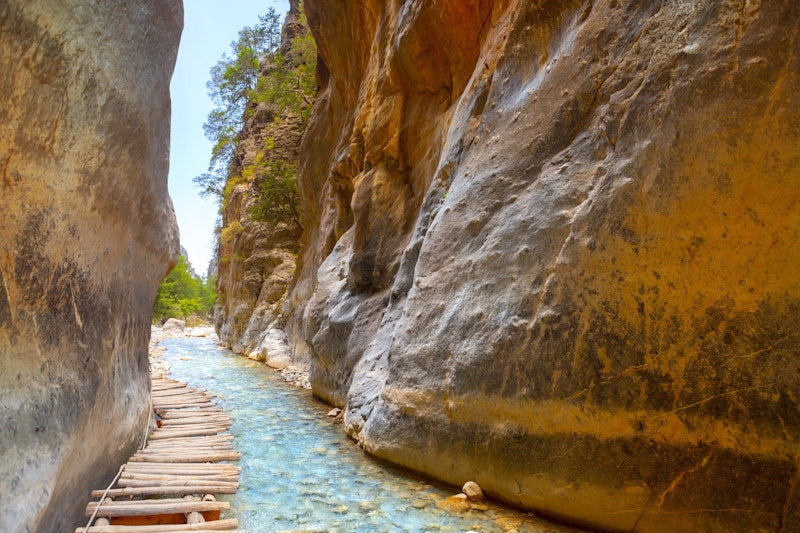
Located in the southwest of Crete, the Samaria Gorge is the longest in Europe and attracts about 500,000 tourists annually, being the second most visited attraction in Crete.
17 km of walking against the backdrop of enchanting landscapes – this, of course, sounds quite extreme, but in fact, you have to go down most of the way, so even not very sports tourists can do such a march.
The starting point of the route is the village of Omalos, where it is recommended to spend the night to get into the gorge with its opening and thus avoid crowds.
In addition to all the delights of the first part of the path, in the second you will find a “feature” of the route – the so-called Iron Gate of Sidiroportes – a passage in which the width of the gorge is up to 3 meters, and the slopes rise up to 300 meters.
The walk ends with an exit to the village of Ayia Roumeli and, finally, to the sea. From here you can reach Chora Sfakion or Sugia by regular sea links, which, in turn, are connected by regular buses to Chania. By the way, the village of Omalos, where our route began, is also easy to reach from Chania by regular bus from the local bus station.
When visiting the Samaria gorge, you are guaranteed a challenging day, as well as a memorable experience.
Oh, and don’t forget to bring some stronger shoes and flasks of water!
11. Palace of Knossos – Ancient Knossos
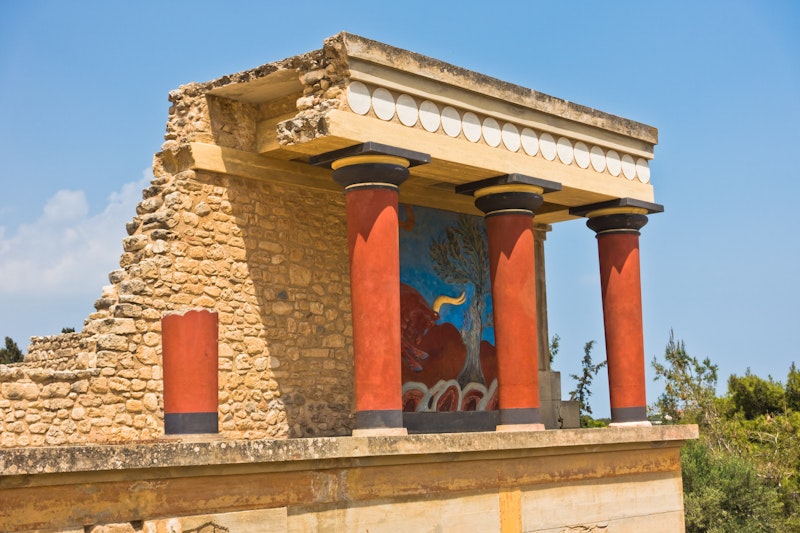
Excavated and partially reconstructed by the British archaeologist Sir Arthur Evans in the early 20th century, the Palace of Knossos is today the most visited attraction in Crete.
The first buildings on this site appeared as early as 6,000 years before the birth of Christ, while the heyday of the Minoan civilization and most of the finds associated with it date back between 2700 and 1450 BC.
The Palace of Knossos, the largest of those that existed in Crete, is considered the centre of the Minoan civilization, at that time one of the most developed in the world. The scale of the site is evidenced by the fact that with more than 1,300 rooms, the Palace of Knossos could accommodate up to 12,000 people.
Knossos is also the legendary headquarters of the equally legendary King Minos, and the place with which one of the most famous Greek myths is associated – the Labyrinth and the Minotaur.
The archaeological site at Knossos is open for visits every day from 8 am to 7 pm during the summer months, and from November to March from 8 am to 3 pm.
Final Thoughts
Crete has so many different places to visit and the activities to do in Crete are more than enough. You can explore enormous geological contradictions – combining breathtaking mountainous parts and beautiful beaches – combined with special weather conditions.
All the places we mentioned can be a good start for a short stay on the island, but it is sure that you will want to come back soon.
